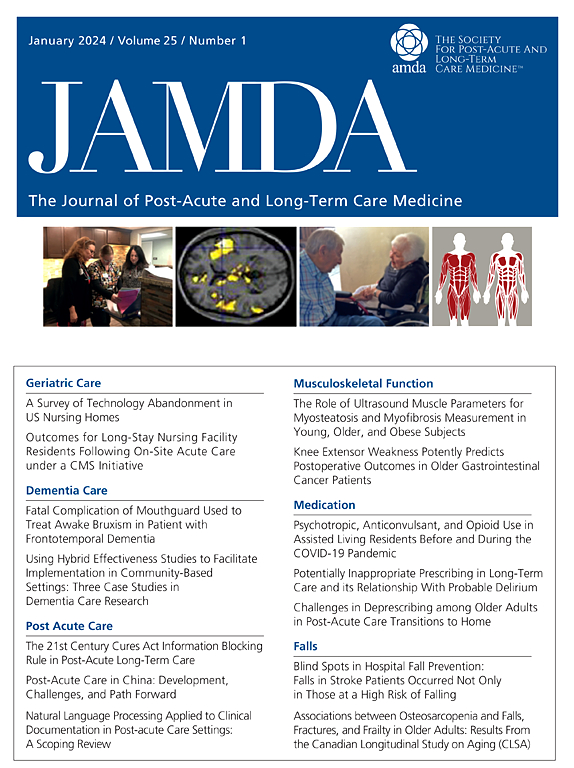A Need for a Time-Out: A Consensus Statement From the Post-Acute and Long-Term Care Medical Association (PALTmed) on the Use of Urine Polymerase Chain Reaction Testing for Urinary Tract Infections
IF 4.2
2区 医学
Q2 GERIATRICS & GERONTOLOGY
Journal of the American Medical Directors Association
Pub Date : 2025-07-19
DOI:10.1016/j.jamda.2025.105746
引用次数: 0
Abstract
Identification and appropriate treatment of urinary tract infections (UTIs) is challenging in post-acute and long-term care (PALTC) settings. Urine polymerase chain reaction (PCR) has emerged as a rapid diagnostic alternative to standard urine culture, gaining increasing adoption in nursing homes despite limited guidance on its appropriate use. In response to concerns regarding clinical utility, a small workgroup composed of members of the Infection Advisory Subcommittee convened in 2024 to develop a consensus statement on urine PCR testing in PALTC settings. A comprehensive literature review identified several issues. Urine PCR demonstrated a high sensitivity for organism detection, including those of unclear clinical significance. This may lead to UTI overdiagnosis. Discrepancies between gene resistance data and phenotypical antibiotic susceptibilities may result in inaccurate antibiotic selection, with a lack of established treatment thresholds further complicating decision-making processes. Moreover, the cost of urine PCR testing is significantly higher than standard urine culture and much of the supporting literature is biased due to industry funding. Most importantly, no objective studies have demonstrated improved patient outcomes associated with the use of urine PCR. Based on these findings, we recommend against the routine use of urine PCR testing for UTI diagnosis in patients who are in PALTC settings. Its widespread use will likely drive unnecessary antibiotic use, increasing the risk of antimicrobial resistance and its associated harms. Further research is needed to firmly define the population of patients who are in PALTC settings who would benefit from urine PCR testing.
需要暂停:急性和长期护理医学协会(PALTmed)关于使用尿聚合酶链反应检测尿路感染的共识声明。
在急性后和长期护理(PALTC)环境中,尿路感染(uti)的识别和适当治疗具有挑战性。尿聚合酶链反应(PCR)已成为标准尿液培养的快速诊断替代方案,尽管其适当使用的指导有限,但在养老院中越来越多地采用。为了回应对临床应用的关注,由感染咨询小组委员会成员组成的小型工作组于2024年召开会议,制定了关于PALTC环境中尿液PCR检测的共识声明。一项全面的文献综述发现了几个问题。尿液PCR对生物检测具有较高的敏感性,包括临床意义不明确的生物检测。这可能导致尿路感染的过度诊断。基因耐药数据与表型抗生素敏感性之间的差异可能导致不准确的抗生素选择,缺乏既定的治疗阈值进一步使决策过程复杂化。此外,尿液PCR检测的成本明显高于标准尿液培养,并且由于行业资助,许多支持文献都有偏见。最重要的是,没有客观的研究表明使用尿液PCR可以改善患者的预后。基于这些发现,我们建议不要常规使用尿液PCR检测PALTC患者的尿路感染诊断。它的广泛使用可能会导致不必要的抗生素使用,增加抗菌素耐药性的风险及其相关危害。需要进一步的研究来确定哪些PALTC患者可以从尿液PCR检测中获益。
本文章由计算机程序翻译,如有差异,请以英文原文为准。
求助全文
约1分钟内获得全文
求助全文
来源期刊
CiteScore
11.10
自引率
6.60%
发文量
472
审稿时长
44 days
期刊介绍:
JAMDA, the official journal of AMDA - The Society for Post-Acute and Long-Term Care Medicine, is a leading peer-reviewed publication that offers practical information and research geared towards healthcare professionals in the post-acute and long-term care fields. It is also a valuable resource for policy-makers, organizational leaders, educators, and advocates.
The journal provides essential information for various healthcare professionals such as medical directors, attending physicians, nurses, consultant pharmacists, geriatric psychiatrists, nurse practitioners, physician assistants, physical and occupational therapists, social workers, and others involved in providing, overseeing, and promoting quality

 求助内容:
求助内容: 应助结果提醒方式:
应助结果提醒方式:


